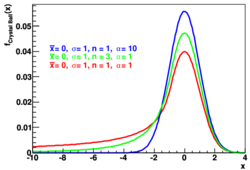Crystal Ball function
From HandWiki
Revision as of 10:25, 15 March 2020 by imported>Importwiki (import)
The Crystal Ball function, named after the Crystal Ball Collaboration (hence the capitalized initial letters), is a probability density function commonly used to model various lossy processes in high-energy physics. It consists of a Gaussian core portion and a power-law low-end tail, below a certain threshold. The function itself and its first derivative are both continuous.
The Crystal Ball function is given by:
- [math]\displaystyle{ f(x;\alpha,n,\bar x,\sigma) = N \cdot \begin{cases} \exp(- \frac{(x - \bar x)^2}{2 \sigma^2}), & \mbox{for }\frac{x - \bar x}{\sigma} \gt -\alpha \\ A \cdot (B - \frac{x - \bar x}{\sigma})^{-n}, & \mbox{for }\frac{x - \bar x}{\sigma} \leqslant -\alpha \end{cases} }[/math]
where
- [math]\displaystyle{ A = \left(\frac{n}{\left| \alpha \right|}\right)^n \cdot \exp\left(- \frac {\left| \alpha \right|^2}{2}\right) }[/math],
- [math]\displaystyle{ B = \frac{n}{\left| \alpha \right|} - \left| \alpha \right| }[/math],
- [math]\displaystyle{ N = \frac{1}{\sigma (C + D)} }[/math],
- [math]\displaystyle{ C = \frac{n}{\left| \alpha \right|} \cdot \frac{1}{n-1} \cdot \exp\left(- \frac {\left| \alpha \right|^2}{2}\right) }[/math],
- [math]\displaystyle{ D = \sqrt{\frac{\pi}{2}} \left(1 + \operatorname{erf}\left(\frac{\left| \alpha \right|}{\sqrt 2}\right)\right) }[/math].
[math]\displaystyle{ N }[/math] (Skwarnicki 1986) is a normalization factor and [math]\displaystyle{ \alpha }[/math], [math]\displaystyle{ n }[/math], [math]\displaystyle{ \bar x }[/math] and [math]\displaystyle{ \sigma }[/math] are parameters which are fitted with the data. erf is the error function.
External links
- J. E. Gaiser, Appendix-F Charmonium Spectroscopy from Radiative Decays of the J/Psi and Psi-Prime, Ph.D. Thesis, SLAC-R-255 (1982). (This is a 205-page document in .pdf form – the function is defined on p. 178.)
- M. J. Oreglia, A Study of the Reactions psi prime --> gamma gamma psi, Ph.D. Thesis, SLAC-R-236 (1980), Appendix D.
- T. Skwarnicki, A study of the radiative CASCADE transitions between the Upsilon-Prime and Upsilon resonances, Ph.D Thesis, DESY F31-86-02(1986), Appendix E.
 |


